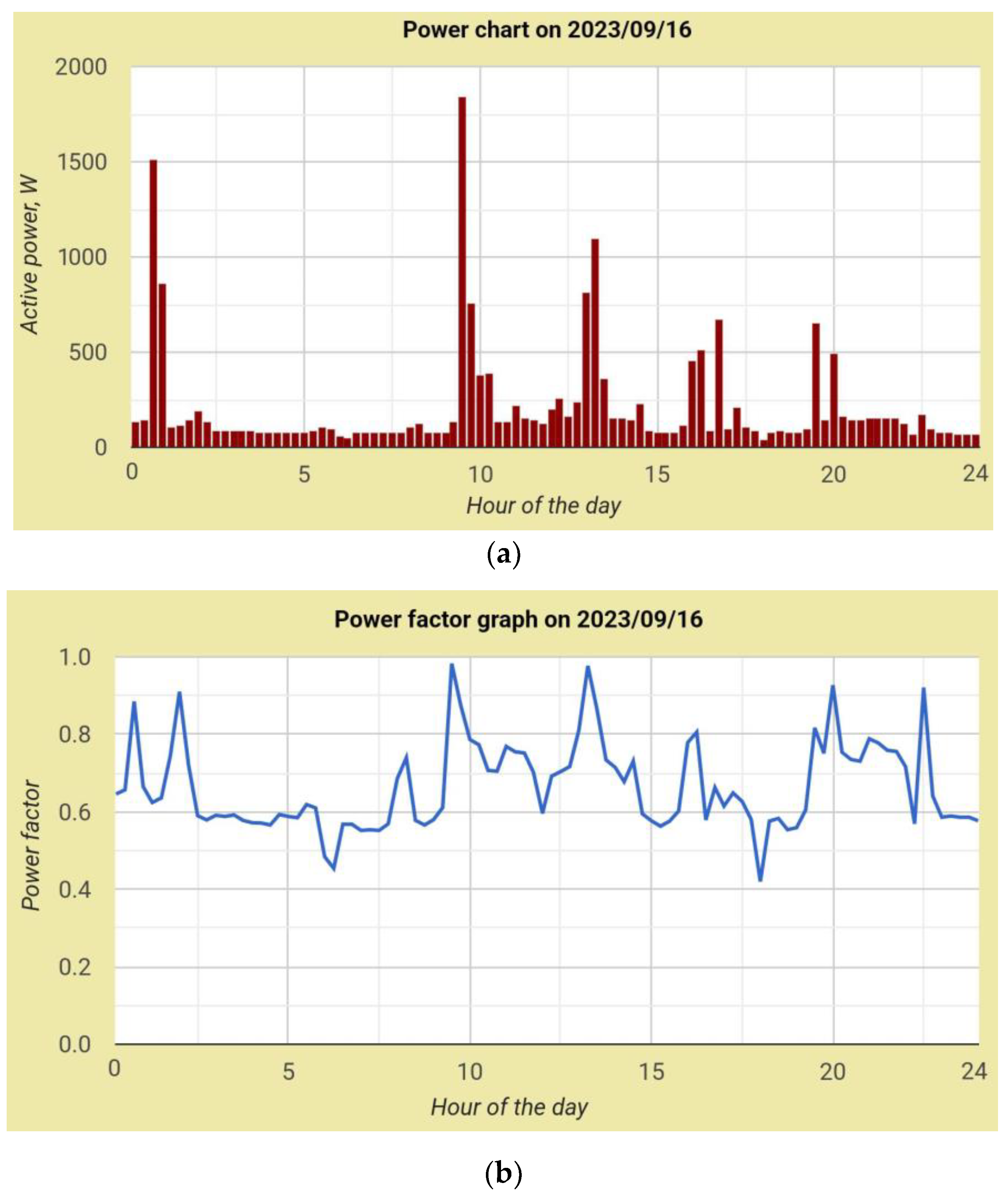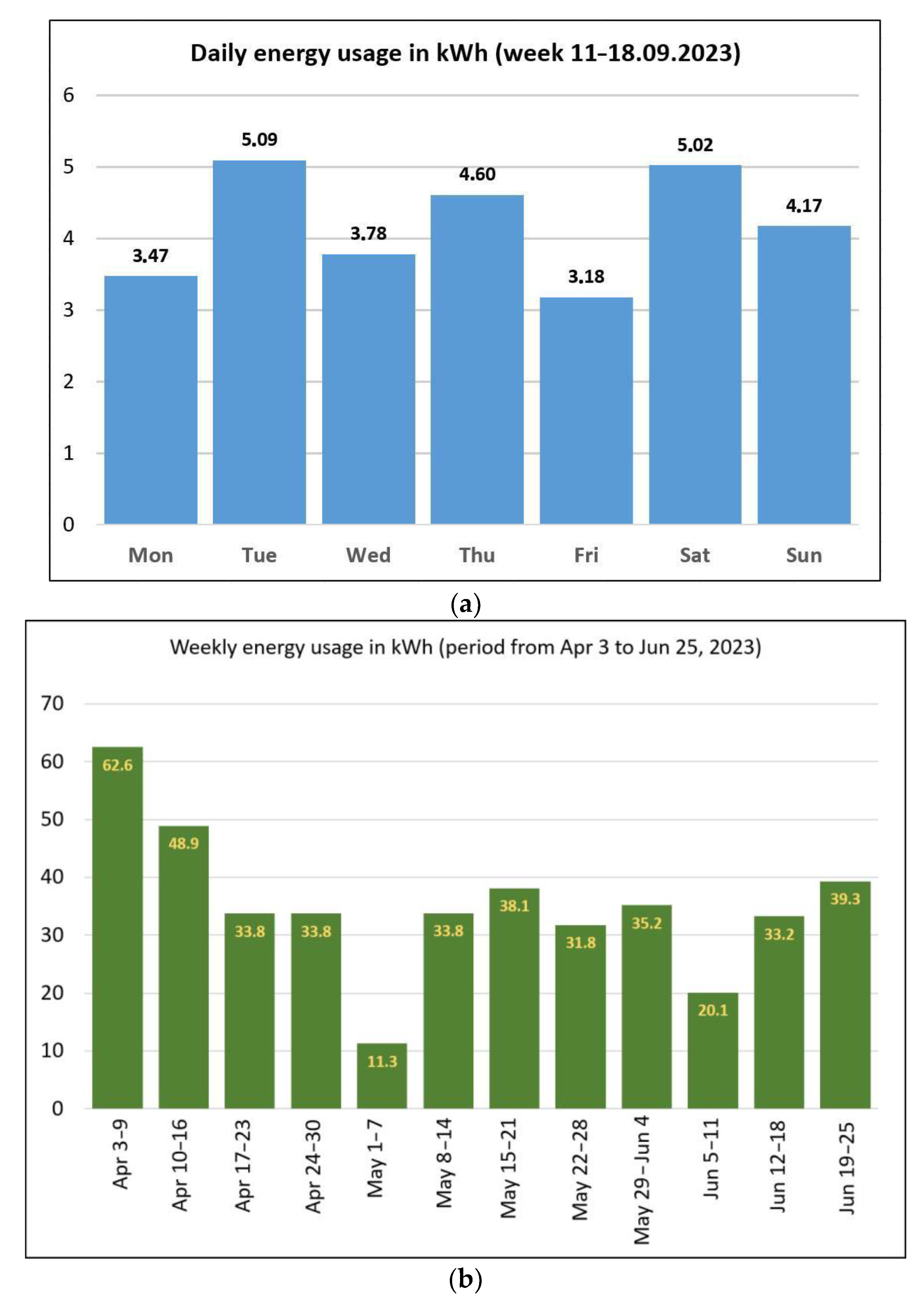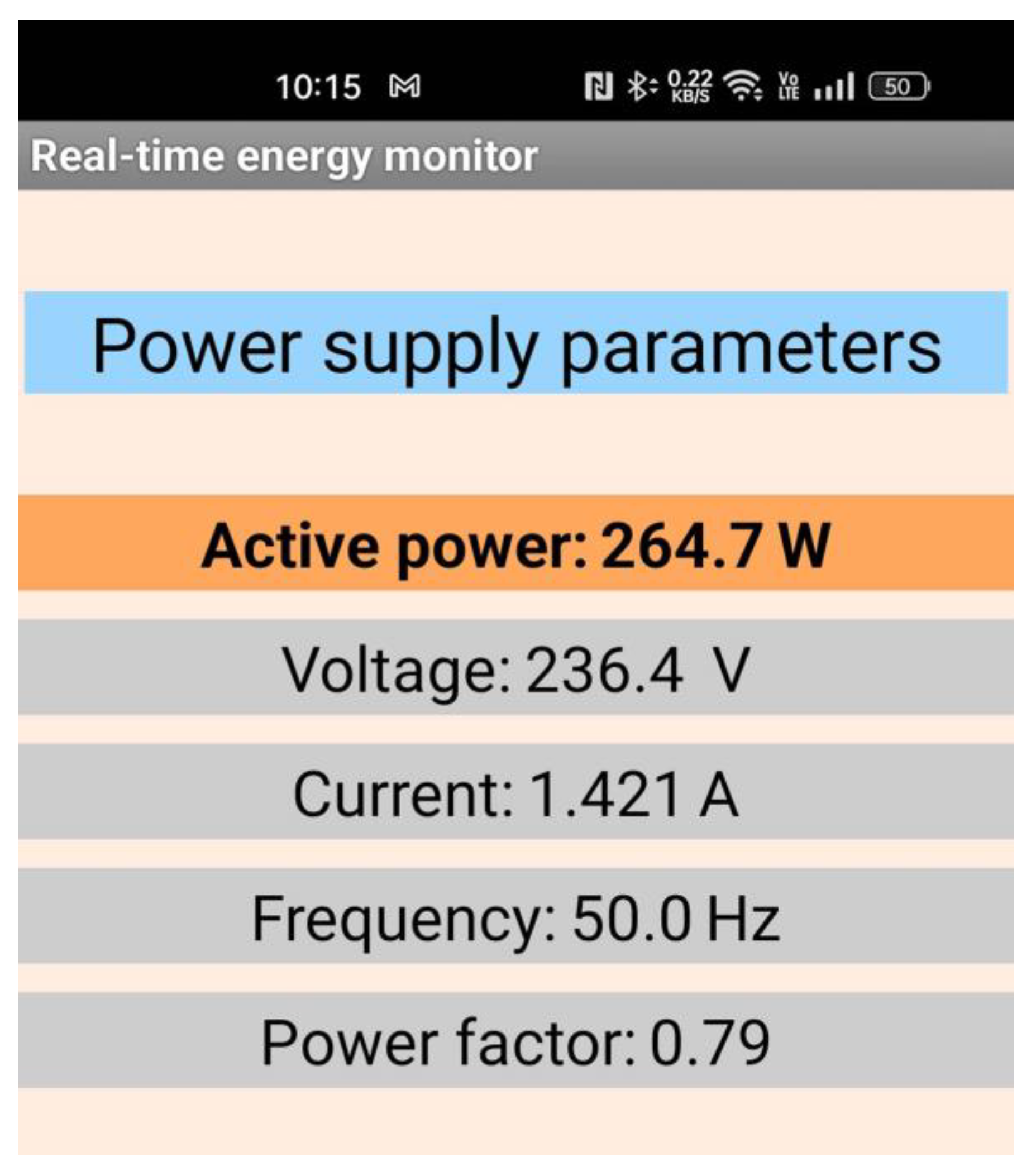Rationalization of Electrical Energy Consumption in Households through the Use of Cheap IoT Module with Cloud Data Storage
Abstract
:1. Introduction
2. Current Status and Prospects for RES Development in Poland
3. Material and Methods
3.1. System for Monitoring Energy Consumption
3.2. Measurement System Software
4. Results of Energy Monitoring and Discussion
5. Conclusions
Funding
Institutional Review Board Statement
Informed Consent Statement
Data Availability Statement
Conflicts of Interest
References
- PSE. Available online: https://www.pse.pl/dane-systemowe/funkcjonowanie-kse/raporty-dobowe-z-pracy-kse (accessed on 15 August 2023).
- GEPL. Available online: https://globenergia.pl/ponad-16-mln-zl-tyle-kosztowalo-polske-ograniczenie-energii-z-oze-w-dwa-dni (accessed on 15 August 2023).
- PGL. Available online: https://www.bloomberg.com/news/articles/2023-04-23/polish-grid-limits-renewable-power-generation-due-to-oversupply (accessed on 19 October 2023).
- Andruszkiewicz, J.; Lorenc, J.; Borowiak, W.; Michalski, A. Time of use tariff design for domestic customers integrating the management goals of efficient energy purchase and delivery. In Proceedings of the 12th International Conference on the European Energy Market (EEM), Lisbon, Portugal, 19–22 May 2015; pp. 1–5. [Google Scholar] [CrossRef]
- Haghdadi, N.; MacGill, I.; Gorman, N.; Passey, R.; Bruce, A. An open source tool for analyzing the impact of electricity network and retail tariffs on consumers. In Proceedings of the 2020 IEEE Power & Energy Society General Meeting (PESGM), Montreal, QC, Canada, 2–6 August 2020; pp. 1–5. [Google Scholar] [CrossRef]
- Ihbal, A.M.; Rajamani, H.S.; Abd-Alhameed, R.A.; Jalboub, M.K. The influence of different tariffs schemes on electricity consumption for the UK domestic buildings. In Proceedings of the Eighth International Multi-Conference on Systems, Signals & Devices, Sousse, Tunisia, 22–25 March 2011; pp. 1–6. [Google Scholar] [CrossRef]
- Moghadam, M.N.; Abapour, M. IoT-based Office Buildings Energy Management with Distributed Edge Computing Capability. In Proceedings of the 8th International Conference on Technology and Energy Management (ICTEM), Mazandaran, Iran, 8–9 February 2023; pp. 1–5. [Google Scholar] [CrossRef]
- Saleem, M.U.; Usman, M.R.; Usman, M.A.; Politis, C. Design, Deployment and Performance Evaluation of an IoT Based Smart Energy Management System for Demand Side Management in Smart Grid. IEEE Access 2022, 10, 15261–15278. [Google Scholar] [CrossRef]
- Mir, U.; Abbasi, U.; Mir, T.; Kanwal, S.; Alamri, S. Energy Management in Smart Buildings and Homes: Current Approaches, a Hypothetical Solution, and Open Issues and Challenges. IEEE Access 2021, 9, 94132–94148. [Google Scholar] [CrossRef]
- Reka, S.S.; Dragicevic, T. Future effectual role of energy delivery: A comprehensive review of Internet of Things and smart grid. Renew. Sustain. Energy Rev. 2018, 91, 90–108. [Google Scholar] [CrossRef]
- Raiker, G.A.; Reddy, B.S.; Umanand, L.; Agrawal, S. Internet of Things based Demand Side Energy Management System using Non-Intrusive Load Monitoring. In Proceedings of the IEEE International Conference on Power Electronics, Smart Grid and Renewable Energy (PESGRE2020), Cochin, India, 2–4 January 2020; pp. 1–5. [Google Scholar] [CrossRef]
- Tsao, T.-F.; Kuo, C.-C. A smart monitoring and control system for the household electric power usage. In Proceedings of the IEEE PES Asia-Pacific Power and Energy Engineering Conference (APPEEC), Hong Kong, China, 8–11 December 2013; pp. 1–4. [Google Scholar] [CrossRef]
- Rokonuzzaman, M.; Mishu, M.K.; Islam, M.R.; Hossain, M.I.; Shakeri, M.; Amin, N. Design and Implementation of an IoT-Enabled Smart Plug Socket for Home Energy Management. In Proceedings of the 5th International Conference on Smart Grid and Smart Cities (ICSGSC), Tokyo, Japan, 18–20 June 2021; pp. 50–54. [Google Scholar] [CrossRef]
- Rahman, M.M.; Van Heerden, C.; Shafiullah, G.M. Electricity Tariffs Evaluation Using Smart Load Monitoring Devices for Residential Consumer. In Proceedings of the 3rd Asia-Pacific World Congress on Computer Science and Engineering (APWC on CSE), Nadi, Fiji, 5–6 December 2016; pp. 265–270. [Google Scholar] [CrossRef]
- Sivakumar, S.A.; Kumar, R.; Ayshwarya, B.; Ponnusamy, H.S.M.; Ganesh, R.S. IoT Based Smart Energy Forecasting and Data Logging System. In Proceedings of the 5th International Conference on Computing Methodologies and Communication (ICCMC), Erode, India, 8–10 April 2021; pp. 783–787. [Google Scholar] [CrossRef]
- Fernandes, J.B.; Sangeetha, D.P.; Padmapriya, G.; Sekar, K. IoT based Energy Assistive Meter to Analyse the Electricity usage in Commercial and Household uses via Wirelessly in a Cloud Network. In Proceedings of the International Conference on Power, Energy, Control and Transmission Systems (ICPECTS), Chennai, India, 8–9 December 2022; pp. 1–4. [Google Scholar] [CrossRef]
- Balamurugan, S.; Saravanakamalam, D. Energy monitoring and management using internet of things. In Proceedings of the International Conference on Power and Embedded Drive Control (ICPEDC), Chennai, India, 16–18 March 2017; pp. 208–212. [Google Scholar] [CrossRef]
- Chaudhari, B.; Shinde, N.; Yelave, G.; Sonawane, G.; Borse, K. Real-Time Electricity Bill Management System Using IoT. In Proceedings of the 5th IEEE International Conference on Emerging Smart Computing and Informatics (ESCI), Pune, India, 1–3 March 2023; pp. 1–5. [Google Scholar] [CrossRef]
- Choudhari, A.; Manekar, A.; Tirgure, M.; Ranglani, S.; Dhongde, P.; Gawai, J. Smart Device for Electricity Management. In Proceedings of the 5th International Conference on Energy, Power and Environment: Towards Flexible Green Energy Technologies (ICEPE), Shillong, India, 15–17 June 2023; pp. 1–6. [Google Scholar] [CrossRef]
- Ravishankar, A.; Vignesh, A.; Vel, V.; Dhiwaakar Purusothaman, S.R.R.; Vijayaraghavan, V. Low-cost non-intrusive residential energy monitoring system. In Proceedings of the IEEE Conference on Technologies for Sustainability (SusTech), Portland, OR, USA, 24–26 July 2014; pp. 130–134. [Google Scholar] [CrossRef]
- Santhosh, P.; Singh, A.K.S.; Ajay, M.; Gaayathry, K.; Haran, H.S.; Gowtham, S. IoT based Monitoring and Optimizing of Energy Utilization of Domestic and Industrial Loads. In Proceedings of the 5th International Conference on Intelligent Computing and Control Systems (ICICCS), Madurai, India, 6–8 May2021; pp. 393–397. [Google Scholar] [CrossRef]
- Adriani, F.; Agung, T.K.; Syafii. IoT System for Household Electrical Appliance Monitoring and Control. In Proceedings of the International Conference on Technology and Policy in Energy and Electric Power (ICT-PEP), Jakarta, Indonesia, 18–20 October 2022; pp. 244–248. [CrossRef]
- Angdresey, A.; Sitanayah, L.; Rumpesak, Z.M.P. An Electricity Consumption Monitoring and Prediction System Based on The Internet of Things. In Proceedings of the Seventh International Conference on Informatics and Computing (ICIC), Denpasar, Bali, Indonesia, 8–9 December 2022; pp. 1–6. [Google Scholar] [CrossRef]
- Hlaing, W.; Thepphaeng, S.; Nontaboot, V.; Tangsunantham, N.; Sangsuwan, T.; Pira, C. Implementation of WiFi-based single phase smart meter for Internet of Things (IoT). In Proceedings of the International Electrical Engineering Congress (iEECON), Pattaya, Thailand, 8–10 March 2017; pp. 1–4. [Google Scholar] [CrossRef]
- Syafii; Luthfi, A.; Rozzi, Y.A. Design of Raspberry Pi Web-based Energy Monitoring System for Residential Electricity Consumption. In Proceedings of the International Conference on Information Technology Systems and Innovation (ICITSI), Bandung, Indonesia, 19–22 October 2020; pp. 192–196. [Google Scholar] [CrossRef]
- TUYA. Available online: https://expo.tuya.com/smart/electrical/meters/electric-energy-meters/CT9cn90yyaumny-CT9cn97xhrpq8v-CT9cnfmde762bm (accessed on 31 August 2023).
- ACREL. Available online: https://www.jsacrel.com/ProDetail/ADW-Series-IoT-wireless-Power-Meter-ADW310-WIFI (accessed on 31 August 2023).
- IAM. Available online: https://www.iammeter.com/products/single-phase-meter (accessed on 31 August 2023).
- ARA. Informacja Statystyczna o Energii Elektrycznej. Ministerstwo Klimatu i Środowiska. Agencja Rynku Energii, S.A. Available online: https://www.are.waw.pl/wydawnictwa#informacja-statystyczna-o-energii-elektrycznej (accessed on 15 August 2023).
- PVA. Available online: https://lepiej.tauron.pl/zielona-energia/fotowoltaika-autokonsumpcja-jak-ja-zwiekszyc/ (accessed on 15 August 2023).
- Faraji Abdolmaleki, S.; Esfandiary Abdolmaleki, D.; Bello Bugallo, P.M. Finding Sustainable Countries in Renewable Energy Sector: A Case Study for an EU Energy System. Sustainability 2023, 15, 10084. [Google Scholar] [CrossRef]
- Kulpa, J.; Olczak, P.; Surma, T.; Matuszewska, D. Comparison of Support Programs for the Development of Photovoltaics in Poland: My Electricity Program and the RES Auction System. Energies 2022, 15, 121. [Google Scholar] [CrossRef]
- Wang, Y.; Lou, S.; Wu, Y.; Wang, S. Flexible Operation of Retrofitted Coal-Fired Power Plants to Reduce Wind Curtailment Considering Thermal Energy Storage. IEEE Trans. Power Syst. 2020, 35, 1178–1187. [Google Scholar] [CrossRef]
- Metodyka Obliczeń Wartości Parametrów Techniczno-Ekonomicznych. Polskie Sieci Elektroenergetyczne 2020. Available online: https://www.pse.pl/documents/20182/98611984/Metodyka_obliczen_wartosci_parametrow_techniczno-ekonomicznych.pdf (accessed on 15 August 2023).
- Maradin, D. Advantages and disadvantages of renewable energy sources utilization. Int. J. Energy Econ. Policy 2021, 11, 176–183. [Google Scholar] [CrossRef]
- Karcz, A.; Burmistrz, P.; Strugała, A. Oszacowanie emisji CO2 związanej z wydobyciem, wzbogacaniem i transportem węgli—Otencjalnych surowców dla procesów wytwarzania wodoru. Polityka Energetyczna 2009, 12, 93–110. Available online: https://min-pan.krakow.pl/wydawnictwo/wp-content/uploads/sites/4/2017/12/karcz-burmistrz-strugala-POL.pdf (accessed on 15 August 2023).
- SBKSE. Available online: https://www.pse.pl/biuro-prasowe/aktualnosci/-/asset_publisher/fwWgbbtxcZUt/content/informacja-osp-w-sprawie-sytuacji-bilansowej-kse-w-okresie-30-12-2022-r-1-01-2023-r- (accessed on 15 August 2023).
- Atănăsoae, P.; Pentiuc, R.D.; Hopulele, E.; Ailoae, I.C.; Irimia, C.F. Analysis of the Price Coupling Mechanism in the Day Ahead Electricity Markets. In Proceedings of the 8th International Conference on Modern Power Systems (MPS), Cluj, Romania, 21–23 May 2019; pp. 1–4. [Google Scholar] [CrossRef]
- TGE. Available online: https://tge.pl/ (accessed on 19 October 2023).
- WNOZE. Available online: https://wysokienapiecie.pl/93216-oze-pokryly-97-zapotrzebowania-polski-piec-godzin-ujemnych-cen-pradu/ (accessed on 19 October 2023).
- PSPP. Available online: https://wysokienapiecie.pl/82421-pge-tauron-i-orlen-zbuduja-elektrownie-szczytowo-pompowe/ (accessed on 19 October 2023).
- Malinowski, M.; Leon, J.I.; Abu-Rub, H. Solar Photovoltaic and Thermal Energy Systems: Current Technology and Future Trends. Proc. IEEE 2017, 105, 2132–2146. [Google Scholar] [CrossRef]
- Kopeć, S.; Lach, Ł.; Spirydowicz, A. Wpływ rozbudowy infrastruktury fotowoltaicznej na rozwój gospodarczy w Polsce—prognoza do 2040 r. Energetyka Rozproszona 2022, 7, 29–53. [Google Scholar] [CrossRef]
- Kopeć, S.; Lach, Ł.; Adamska, B.; Wrocławski, M.; Szczeciński, P. Wpływ Rozbudowy Infrastruktury Magazynów Energii na Rozwój Gospodarczy w Polsce—Prognoza do 2040 r. Analizy AGH. 2022. Available online: https://psme.org.pl/wp-content/uploads/2022/05/RAPORT_komunikat-2_2022.pdf (accessed on 15 August 2023).
- Farinet, D.; Maurer, M.; Vacca, L.; Spataru, S.V.; Stroe, D.-I. Battery Lifetime Analysis for Residential PV-Battery System used to Optimize the Self Consumption—A Danish Scenario. In Proceedings of the IEEE Energy Conversion Congress and Exposition (ECCE), Baltimore, MD, USA, 29 September–3 October 2019; pp. 6693–6698. [Google Scholar] [CrossRef]
- Cetinkaya, U.; Demirbas, S.; Ayik, S.; Bayindir, R. Battery Energy Storage Systems in Different Countries for Arbitrage Services. In Proceedings of the 11th International Conference on Smart Grid (icSmartGrid), Paris, France, 4–7 June 2023; pp. 1–5. [Google Scholar] [CrossRef]
- Agrela, J.C.; Rezende, I.; Soares, T. Analysis of battery energy storage systems participation in multi-services electricity markets. In Proceedings of the 18th International Conference on the European Energy Market (EEM), Ljubljana, Slovenia, 13–15 September 2022; pp. 1–6. [Google Scholar] [CrossRef]
- Augustine, C.; Blair, N. Energy Storage Futures Study: Storage Technology Modeling Input Data Report. Golden, CO: National Renewable Energy Laboratory, 2021. NREL/TP-5700-78694. Available online: https://www.nrel.gov/docs/fy21osti/78694.pdf (accessed on 15 August 2023).
- Siewierski, T.; Malarek, A. Optimization of Battery Storage Capacity and Operation for Balancing Residential PV Installation. In Proceedings of the 14th International Conference on Software, Knowledge, Information Management and Applications (SKIMA), Phnom Penh, Cambodia, 2–4 December 2022; pp. 104–109. [Google Scholar] [CrossRef]
- Hamanee, S.; Wahlstedt, E.; Lazarou, S.; Theocharis, A. Measurements and analysis of electrical power consumption patterns for the computation of an aggregated battery energy storage system. In Proceedings of the IEEE International Conference on Environment and Electrical Engineering and 2020 IEEE Industrial and Commercial Power Systems Europe (EEEIC/I&CPS Europe), Madrid, Spain, 9–12 June 2020; pp. 1–6. [Google Scholar] [CrossRef]
- Haegel, N.M.; Kurtz, S.R. Global Progress Toward Renewable Electricity: Tracking the Role of Solar. IEEE J. Photovolt. 2021, 11, 1335–1342. [Google Scholar] [CrossRef]
- Zawada, M.; Szajt, M. Energy Consumption in Poland—Global and Sector Perspective. In Proceedings of the 5th International Conference on the European Electricity Market, Lisbon, Portugal, 28–30 May 2008; pp. 1–4. [Google Scholar] [CrossRef]
- Kumar, S.; Madlener, R. Renewable energy roadmap for central Europe until 2050: A scenario based techno-economic analysis. In Proceedings of the 21st Century Energy Needs—Materials, Systems and Applications (ICTFCEN), Kharagpur, India, 17–19 November 2016; pp. 1–6. [Google Scholar] [CrossRef]
- Angheluta, S.P.; Burlacu, S.; Diaconu, A.; Curea, C.S. The Energy from Renewable Sources in the European Union: Achieving the Goals. Eur. J. Sustain. Dev. 2019, 8, 57–65. [Google Scholar] [CrossRef]
- IZEE. Available online: https://nowa-energia.com.pl/2022/12/19/ile-zaplacimy-za-energie-elektryczna-od-stycznia-2023-r (accessed on 15 August 2023).
- Wyciąg z Taryfy Dla Energii Elektrycznej w Zakresie Dystrybucji Energii Elektrycznej TAURON Dystrybucja, S.A. na rok. 2023. Available online: https://www.tauron-dystrybucja.pl/-/media/offer-documents/dystrybucja/aktualna-taryfa/wyciag-z-taryfy-td-sa-na-rok-2023-dla-odbiorcow-grup-g.ashx (accessed on 15 August 2023).
- Taryfa Dla Energii Elektrycznej Sprzedaży Kompleksowej z Urzędu TAURON Sprzedaż GZE Spółka z o.o. Available online: https://www.tauron.pl/-/media/offer-documents/dokumenty-do-taryfy/taryfa-dokumenty/taryfa-sprzedawcy/gze-1-01-2021/20220201-gze-taryfa-sprzeda%C5%BC-gze-g-k-www.ashx (accessed on 15 August 2023).
- PZEM-004T Voltage Current Watt Meter Single Phase. Product Parameters. Ningbo Peacefair Electronic Technology. Available online: http://en.peacefair.cn/products/3487.html (accessed on 15 August 2023).
- Power Network Meter ND30. User’s Manual. LUMEL S.A. 2022. Available online: https://www.lumel.com.pl/resources/Pliki%20do%20pobrania/ND30/ND30_service_manual.pdf (accessed on 15 August 2023).
- Cora, A.; Güçlü, H. A complete solution for the problem of eliminating residential stand-by power and protecting them against over voltage and over current. In Proceedings of the International Symposium on Innovations in Intelligent Systems and Applications, Trabzon, Turkey, 2–4 July 2012; pp. 1–5. [Google Scholar] [CrossRef]
- Mcgarry, L. Standby power challenge. In Proceedings of the International IEEE Conference on the Asian Green Electronics (AGEC), Hong Kong, China & Shenzhen, China, 7–9 January 2004; pp. 56–62. [Google Scholar] [CrossRef]
- Gram-Hanssen, K.; Kofod, C.; Nærvig Petersen, K. Different everyday lives: Different patterns of electricity use. In Proceedings of the ACEEE Summer Study on Energy Efficiency in Buildings, Pacific Grove, CA, USA, 22 August 2004; pp. 1–13. [Google Scholar]











| Number of Days | PZEM-004T Measurement EP | Watt-Hour Meter Measurement EW | Percentage Difference (EP − EW)/EP × 100 |
|---|---|---|---|
| 192 | 1053.7 kWh | 1046 kWh | 0.73% |
| Days | Peak Energy | Off-Peak Energy | Cost G11 1 | Cost G12 1 |
|---|---|---|---|---|
| 192 | 645 kWh | 401 kWh | 758.31 PLN | 714.94 PLN |
| Tariff and Share of Off-Peak Energy | G11 | G12 (10%) | G12 (20%) | G12 (30%) | G12 (40%) | G12 (50%) |
|---|---|---|---|---|---|---|
| Annual cost (frozen rates), PLN 1 | 1667 | 1872 | 1766 | 1660 | 1554 | 1448 |
| Annual savings after switching from G11 to G12 tariff, PLN | – | −205 | −99 | 7 | 113 | 219 |
| Annual cost (2023 rates), PLN 1 | 3973 | 4409 | 4190 | 3971 | 3752 | 3532 |
Disclaimer/Publisher’s Note: The statements, opinions and data contained in all publications are solely those of the individual author(s) and contributor(s) and not of MDPI and/or the editor(s). MDPI and/or the editor(s) disclaim responsibility for any injury to people or property resulting from any ideas, methods, instructions or products referred to in the content. |
© 2023 by the author. Licensee MDPI, Basel, Switzerland. This article is an open access article distributed under the terms and conditions of the Creative Commons Attribution (CC BY) license (https://creativecommons.org/licenses/by/4.0/).
Share and Cite
Boron, S. Rationalization of Electrical Energy Consumption in Households through the Use of Cheap IoT Module with Cloud Data Storage. Sustainability 2023, 15, 15507. https://doi.org/10.3390/su152115507
Boron S. Rationalization of Electrical Energy Consumption in Households through the Use of Cheap IoT Module with Cloud Data Storage. Sustainability. 2023; 15(21):15507. https://doi.org/10.3390/su152115507
Chicago/Turabian StyleBoron, Sergiusz. 2023. "Rationalization of Electrical Energy Consumption in Households through the Use of Cheap IoT Module with Cloud Data Storage" Sustainability 15, no. 21: 15507. https://doi.org/10.3390/su152115507
APA StyleBoron, S. (2023). Rationalization of Electrical Energy Consumption in Households through the Use of Cheap IoT Module with Cloud Data Storage. Sustainability, 15(21), 15507. https://doi.org/10.3390/su152115507






